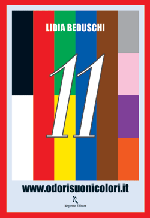Istructions
Lidia Beduschi, About the book "11", and how to use it (scented colors, touch-readable symbols, and sounds)
It is now the time to tell you how to use your kit, which comprises the book, that you surely have aldready touched and leafed through, "History of 11", that you will find here on the website, and the "Games", at the end of the colors' tale.
The book is made of 11 cardboard sheets, one for each color (black, white, red, green, blue, brown, gray, pink, purple, orange), separated by lighter leaves, plus 11 more cardboard sheets (always black, white, red, green, blue, brown, gray, pink, purple, orange) pre-cut in rectangular pieces that you can cut to play the Games. The 22 sheets are ring-bound. In the bottom center section of each colored sheet, you will find the symbol in touch-readable dots. The cardboard sheets are scented, as you will have already found out: to smell each color's scent, just rub the sheet with your fingers, applying a gentle pressure. The pressure will break the micro-capsules, releasing a long-lasting water-based essence. Further on, you can read a description of the essence's chemical composition.
Why 11 colors? And why just these 11 colors?
We did not choose them randomly. You must know that these are the colors known to the majority of the world's population, as shown in the research of two American anthropologists, Brent Berlin and Paul Kay. The two researchers wrote down their results in an important essay, Basic Color Terms, published in Berkley, by University of California Press, in 1969.
Why do colors come in this order?
This is not a random order! The group of the 11 colors can be divided into six stages of growing complexity. The first stage comprises two colors: black and white. It is the simplest and oldest stage. The second stage comprises red. The third comprises two colors: green and yellow. The fourth comprises blue. The fifth, brown. The sixth comprises four colors: gray, pink, purple, orange.
Most peoples and culture went through all these stages. Ancient Greek, the language of Homer's Ilias and Odissey, is, according to our two anthropologists, in the third stage, and knows the colors leukòs (white), glaukòs (black), eruthròs (red), and khloròs (meaning both "yellow" and "green").
It is very important to underscore that when a culture goes from a stage to the next, the change always goes in the direction we described. For instance, if, and when, a culture goes from a two-stage, three-color system (black and white; red) to a five-stage, seven-color system, this culture will necessarily have, in succession: black and white; red; green and yellow; then blue, and at last brown.
Is this the case with all peoples and cultures?
Not with all of them, but in most cases, as we said before. This is the case even with Ancient Greeks, who used, as we just saw, the same word khloròs for both green and yellow. And it is the case with contemporary Japan, where, until recently, there was just one word, aoi, for blue and green. Nowadays, young Japanese will use the word midori to say green, but the "bluegreen" of a traffic-light is still called aoi.
And now, let's proceed with the explanation of the codes (remember, a code is an "alphabet" of sorts!) matching:
- Printer-friendly version
- Login to post comments
 Italiano
Italiano

